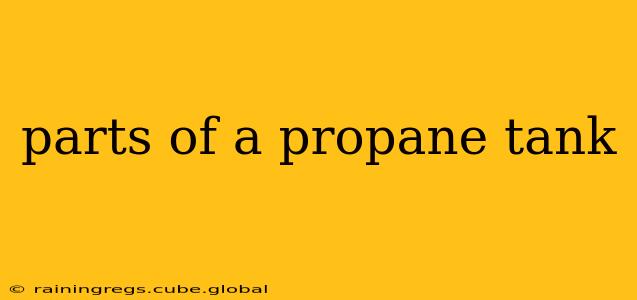Propane tanks are ubiquitous, powering everything from backyard grills to home heating systems. But how much do you really know about the components that make up these seemingly simple cylinders? Understanding the parts of a propane tank is crucial for safety, maintenance, and ensuring optimal performance. This comprehensive guide will break down the key components and their functions.
What are the Main Parts of a Propane Tank?
A propane tank, regardless of size, generally consists of several key parts working in concert:
-
Cylinder Body: This is the main cylindrical structure, typically made of steel or aluminum, designed to withstand significant pressure. The thickness of the cylinder wall varies depending on the tank's capacity and intended use. The strength of this body is paramount to safe propane storage.
-
Valve Assembly: Located at the top of the tank, this crucial component controls the flow of propane. It includes the valve stem, which is opened and closed to regulate gas release, and various safety features like an overfill prevention device (OPD) to prevent overfilling.
-
Overfill Protection Device (OPD): This is a critical safety feature integral to the valve assembly. The OPD prevents overfilling the tank, reducing the risk of dangerous pressure buildup. It also incorporates a pressure relief valve that releases excess pressure if it becomes dangerously high.
-
Tank Foot/Base: Larger, stationary propane tanks often have a base or foot to provide stability and prevent tipping. This is less common in smaller, portable tanks.
What are the Safety Features of a Propane Tank?
Safety is paramount when handling propane. Several features are built into the tank and its components to minimize risks:
-
Pressure Relief Valve: As mentioned above, this valve is a part of the OPD and is designed to release excess pressure should it exceed safe levels. This prevents dangerous ruptures or explosions.
-
Fusible Plug: Some tanks may incorporate a fusible plug, a metal plug designed to melt at a specific high temperature, releasing pressure if a fire occurs. This is a secondary safety mechanism.
What are the Different Types of Propane Tanks?
Propane tanks come in various sizes and designs, each suited for different applications:
-
Small, Portable Tanks: These are the commonly seen tanks used for grills and camping stoves. They typically range from 1-20 pounds.
-
Large, Stationary Tanks: These larger tanks are often buried underground or placed on a stand and are used to supply propane to homes or businesses. They range significantly in size, holding hundreds of gallons.
How do I Know When My Propane Tank Needs to be Replaced?
Propane tank lifespan depends on several factors, including usage and material. Visual inspections should be regularly conducted. Signs of rust, dents, or other damage warrant professional inspection and potential replacement. It is crucial to adhere to the manufacturer's recommendations and local regulations regarding tank replacement.
How Often Should I Inspect My Propane Tank?
Regular inspections are essential for safe propane usage. It's advisable to visually inspect your tank at least once a month. Look for signs of corrosion, leaks, dents, or damage to the valve assembly. Any concerns should be addressed by a qualified propane professional.
What Happens if a Propane Tank Leaks?
A propane leak is a serious hazard. If you suspect a leak, immediately evacuate the area, and contact your local fire department and a qualified propane technician. Never attempt to repair a leaking propane tank yourself.
This comprehensive guide sheds light on the key parts of a propane tank and the importance of safety and regular maintenance. Remember, responsible handling of propane is crucial to prevent accidents and ensure its safe and efficient use.
